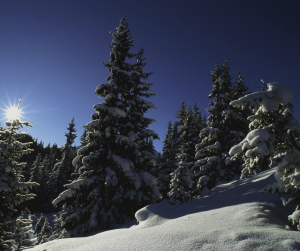Color Analysis to the Rescue – How to Know if You’re a Winter
The goal of seasonal color analysis is to create visual harmony by selecting a color palette that relates to your natural coloring. When you utilize the colors that are inherent in you, people are focused on you and not your clothing. A personal color analysis is the tool that enables you to determine your season, and thereby, your best colors. The seasons, however, go beyond best colors. Not only does each season relate to particular color qualities, but also design style and even personality. So, let’s look at the season of Winter.

When I picture the Winter color palette, I think of a snow-capped winter landscape. Winter is awe-inspiring in its beauty and silence. There is starkness in a winter scene. The sharp contrasts of white snow and the deep forest color of evergreen trees silhouetted against electric blue skies. Icicles sparkle and purple shadows fall on the snow. There is a sense of vitality with strong blacks, deep blues, dark greens, and the sudden reds of flaming poinsettias. Winter in her frozen splendor is regal, dignified and reigns with a commanding air. There is a feeling of space and stillness as nature is at rest.
Are you a Winter?
Winter Personality Traits

If you look at the picture of the winter landscape, it’s simple yet striking. This is also true for the people of the Winter season. There are mainly two types of Winters. The determined East Coast type and the regal Jackie O type. What Winters generally have in common is that they project a sense of calm restraint. They are often classic, refined, stately, dignified, and formal. Along with their elegance, Winters can often be perfectionists and become single-minded when working on projects. Two traits I find to be almost universal with Winters is that they rarely look casual (even in casual clothing) and can seem aloof or intimidating to others. To be a Winter, you may not fit all of these descriptions and adjectives as they are certainly generalizations
Winter Coloring
Winters are lit by moonlight – the light as the moon is high in the sky. Nature paints these people in a black and white etching – dramatic and refined. They are dark, cool, and intense. Given their contrast and ability to wear intense colors, they are rarely, if ever, naturally light haired. The exception is a Winter who has gone gray or white. That doesn’t mean, however, that all Winters have light skin coloring. Winters are generally dark haired with cool, light skin or dark hair and dark skinned.They key to whether or not someone is a Winter is that they are most harmonious in intense, cool, and contrasted colors.

Winters most commonly have cool, dark hair with a base color ranging from medium cool brown to black. A great benefit of being a Winter is that you look most harmonious with your natural hair color, so no need to spend money dying it! They also gray beautifully! Winters often have heavy, dark eyebrows and can have a range of eye colors including hazel, blue, green, brown and very dark brown (almost look black). In terms of skin tone, they often have a translucent look to their skin and may or may not tan. Their skin can be porcelain, ivory, and even olive or golden colors that range from light to dark. Again, the key is how the skin reacts to color. All Winters react beautifully to cool colors with strong intensity.
Winter Color Palette
 Like with this picture of red roses, the Winter Color Palette has a sense of drama and elegance. Although Winters are the only season to rock pure pigments – think primary colors – the key to their colors is actually contrast versus intensity. When looking for Winter colors, look for brilliant, pure pigments in darker value colors along with pale icy colors for contrast. For icy colors, think of ice pink and ice blue (the color at the edges of snow) not true Easter pastel colors.
Like with this picture of red roses, the Winter Color Palette has a sense of drama and elegance. Although Winters are the only season to rock pure pigments – think primary colors – the key to their colors is actually contrast versus intensity. When looking for Winter colors, look for brilliant, pure pigments in darker value colors along with pale icy colors for contrast. For icy colors, think of ice pink and ice blue (the color at the edges of snow) not true Easter pastel colors.
Some of the worst colors for Winters are soft, muted colors or truly warm colors like Earth tones and harvest colors. Winter is the only season for which black is a color. A Winter can still shine in pure black and pure white whereas other seasons look best when using these “colors” in small doses or not at all. If you feel that black overpowers you, but your overall coloring is cool, then you may fit better into Summer.
The flowers of winter are also a great inspiration for the palette as they illuminate the sense of drama for the season perfectly. Winter flowers include: Roses, Gardenias, Poinsettias, and Fuchsias.
Types of Winters
Seasonal color analysis usually categorizes 3 or 4 winter types. 12-season analysis has Dark, True, and Bright Winters and then the 16-season color analysis adds Cool Winter and changes the name of Bright Winter to Clear Winter. If you’re not sure if you’re a Winter or need to know the type of Winter you are, consider having a personal color analysis done and discover how knowing your best colors can be life changing.

Deep Winter
Deep Winter (also called Dark Winter) is the season that flows to Autumn. Individuals tend to have a deep eye color and very dark hair. Their skin tone can range from pale to dark. They are the most exotic looking of the Winter seasons. The palette is neutral to cool, predominately dark, with moderately clear/intense colors. Colors included in this palette include wine, burgundy, navy, deep purple, deep forest green, and black. Soft and muted have no place in the Deep Winter closet. Celebrity examples include Kim Kardashian, Monica Bellucci, and Sandra Bullock.
Cool Winter
Cool Winter is the season that flows to Summer, so the people and colors are the softest of the Winter seasons, but still not soft. Their hair is medium to dark brown and they often have colored eyes – blue, green or gray. They have a medium to high contrast and tend to have light skin. They look best in cool-toned, moderately bright colors that are medium to moderately deep in value. Cool Winters will have many overlapping colors with Cool Summer. Colors that are common to this palette include cranberry, magenta, navy, wine, deep blue-green, and charcoal. Warm colors have no place in either of these sub-seasons. Celebrity examples include: Jaime Alexander, Elizabeth Taylor and Audrey Hepburn.
True Winter
True Winter is the quintessential classic Winter. Their hair is generally quite dark and they either a high contrast between their hair and skin or have very dark skin and hair. True Winters are often the most regal, dignified, and elegant of all of the Winters. They look best in cool and clear colors ranging from icy to deep. Colors common to this palette include true blue-red, cobalt blue, royal purple, and magenta. Celebrity examples include: Jackie O, Jennifer Connelly, and Naomi Campbell.
Clear Winter
Clear Winter (also called Bright Winter) is the season that flows to Spring, thus the personality and colors of this sub-season tends to be the brightest. Their hair is generally quite dark and they often have electric eyes and fair skin. They look best in neutral to cool very clear colors that range from icy to quite deep and intense. Colors common to this palette include true red, cobalt blue, royal purple, lemon yellow, and emerald green. Celebrity examples include: Megan Fox, Teri Hatcher, and Lupita Nyong’o.
Do any of these Winter types sound like you? I’d love to hear how you do Winter in the comments!
Ready to discover your season?
Check out my services page for a professional virtual color analysis. If you’d rather discover your season on your own, then consider purchasing my Color Analysis Master Class that I created in parternship with Outfit Formulas®.
